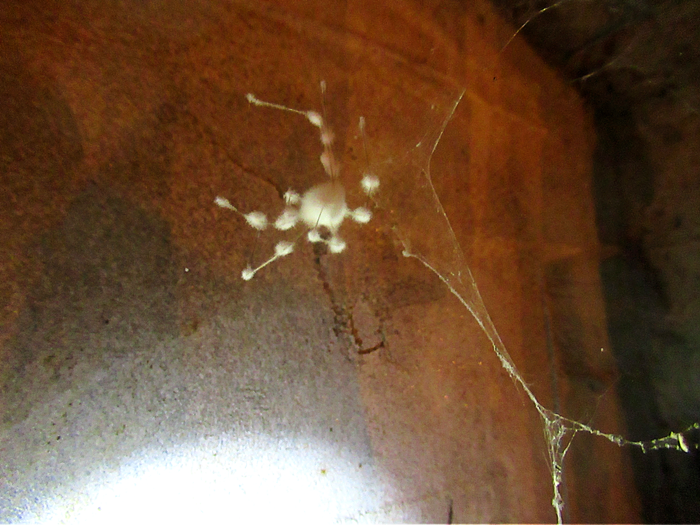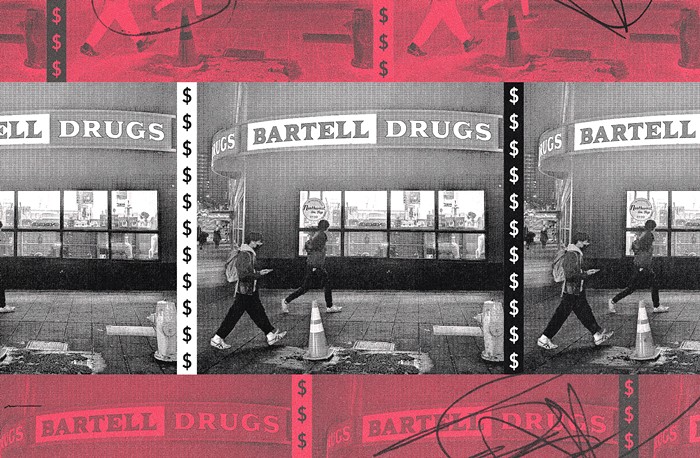That black curtain in the alcove.
You might not even notice it on crowded nights at Underbelly when your favorite local band is performing their first live show since COVID or you have to wrestle through a harem of drag queens just to order a drink.
But on a rainy October day, in the late afternoon, the curtain calls to you. On days when everything outside is like what somebody who’s never set foot in Seattle would think Seattle looks like. Rain tapping on the cast iron and glass of the Pioneer Square pergola. Rain dripping from the totem pole onto a pile of wet leaves.
It’s so exaggerated and dramatic it’s like the city is doing a drag version of itself.
This is the season when you slip down the wet steps into the Underbelly: the bar inside Dexter Horton’s old bank vault. Seattle’s first banker, Dexter Horton, had his secrets. He got such a good deal on his first safe because it had no back. Everybody just trusted that their money was secure. His old building is still full of secrets.
The biggest secret? What. Is. Behind. That. Black. Curtain?

If the bar’s not busy—and if you get there right when they open at 4 pm it often isn’t—order a drink, tip nice, and ask the bartender about that curtain.
For those who never took the mandatory boring-even-for-a-field-trip tour of the Seattle underground back in fifth grade, the bartender will fill you in on the Great Seattle Fire. How the old wooden city burned to the ground in 1889. How after the fire the city decided to raise the street level two stories to stop the sewers from backing up at high tide and bury all of old Pioneer Square. It explains why, when you look out the huge windows that reach all the way up to the 19th-century coffered ceiling, you see the sidewalk.
But about the curtain.
It’s the building’s old entrance, connected to the old underground sidewalk.
Behind that curtain is a section of the underground not advertised and not available on any tour. Not even Nancy Drew got to see any of this when she ventured into the Seattle underground to retrieve the missing orca paintings and save the vice president from being blown up with fireworks in the 1996 Seattle classic Murder on the Fourth of July.

No dry history down here, these underground tunnels are very alive. Literally. It’s an ever-changing subterranean ecosystem. All kinds of mushrooms grow from the brick and cement in all kinds of colors, mostly green and tan. All life needs is a little moisture.
In addition to being alive, these tunnels are also undead. That spider-eating zombie fungus from The Last of Us? It is real. The white fungus-covered spiders here look like crumbs of Frosted Mini-Wheats or tiny yetis. The Last of Us can go eat a zombie dick for filming their Seattle-set season in Vancouver. We don’t need their show, we have the real thing.

Those who like history and urban explorer vibes will be right at home. The ancient broken pipes are so corroded they look like tree bark. You turn a corner and pass a cinderblock-sealed window that, back in the 1890s, you could’ve poked your head out for a view of the ferry docks.

At the end of the tunnel, you encounter an ominous boarded-up door, a pile of bricks, and the story of the mysterious ever-changing bones of the Underbelly.
Back in 2020, a bartender told me that this was where they discovered a human skeleton while cleaning out debris for the bar opening. At first, they thought it was the skeleton of a child, but an alleged forensic examination revealed it was the skeleton of an extremely malnourished adult woman.
The recent date of the remains was apparently too morbid a story because when I went back to the Underbelly a couple of days ago the owner, Rachel Wilcox, told me the bones were of a woman who died in the early 20th century. Back in 2020, it was a complete set of bones, but now the story goes that the skeleton was headless and the skull was never found!!!!
Wilcox also explained that the skeleton was not found during the Underbelly opening, but a couple of years earlier, in either 2016 or 2017, by a construction company putting in new wood supports. She did not know the name of the company that found the bones and had never actually seen them.
I could not find any news coverage of human remains in the underground from 2016 or 2017, but having personally written local history articles for the Seattle Weekly during that same time period—when all local media was collapsing—I have no doubt that the bones of an early 20th-century murder victim could have been discovered without receiving any coverage.
Wilcox also stressed that bartenders are not professional historians. You can’t deny them tenure if it turns out they were embellishing details. “We just let folks know that it’s not 100% verified… same as most ghosts.”
Intrigued, I went back up above ground, walked over a block, and then back down below ground into the home base of the Beneath the Streets tour. The guides all knew about the Underbelly bones, but also couldn’t confirm it.
Beneath the Streets strives to be the most historically accurate underground tour in town, but with something like the Seattle underground there is a giant limit on how accurate it’s possible to be. The stories have a way of drifting underground.
From 1907, when the underground was shut down to prevent plague, to 1965, when Bill Speidel’s Underground Tour opened to tourists, Pioneer Square was Seattle’s primary vice district and it wasn’t exactly inviting towards people asking a lot of questions or trying to document what went on there, even above ground.
Most law-abiding citizens of Seattle forgot all about the subterranean sidewalks. When the Seattle Times columnist John Reddin wrote an article about his visit underground in the early ‘60s most people thought it was a hoax.
An over-the-top supervillain like the mad scientist in the 1973 Seattle horror film The Night Strangler could not have created a better place to kill his victims than a soundproof, subterranean lair beneath a vice district. How can you get caught when you kill somebody inside an urban legend?
Even now when you stand on the patch of dirt where the murder supposedly happened you cannot hear any of the music coming from the club. On those nights, when your favorite band is playing, nobody would know what’s going on on the other side of the brick wall.















